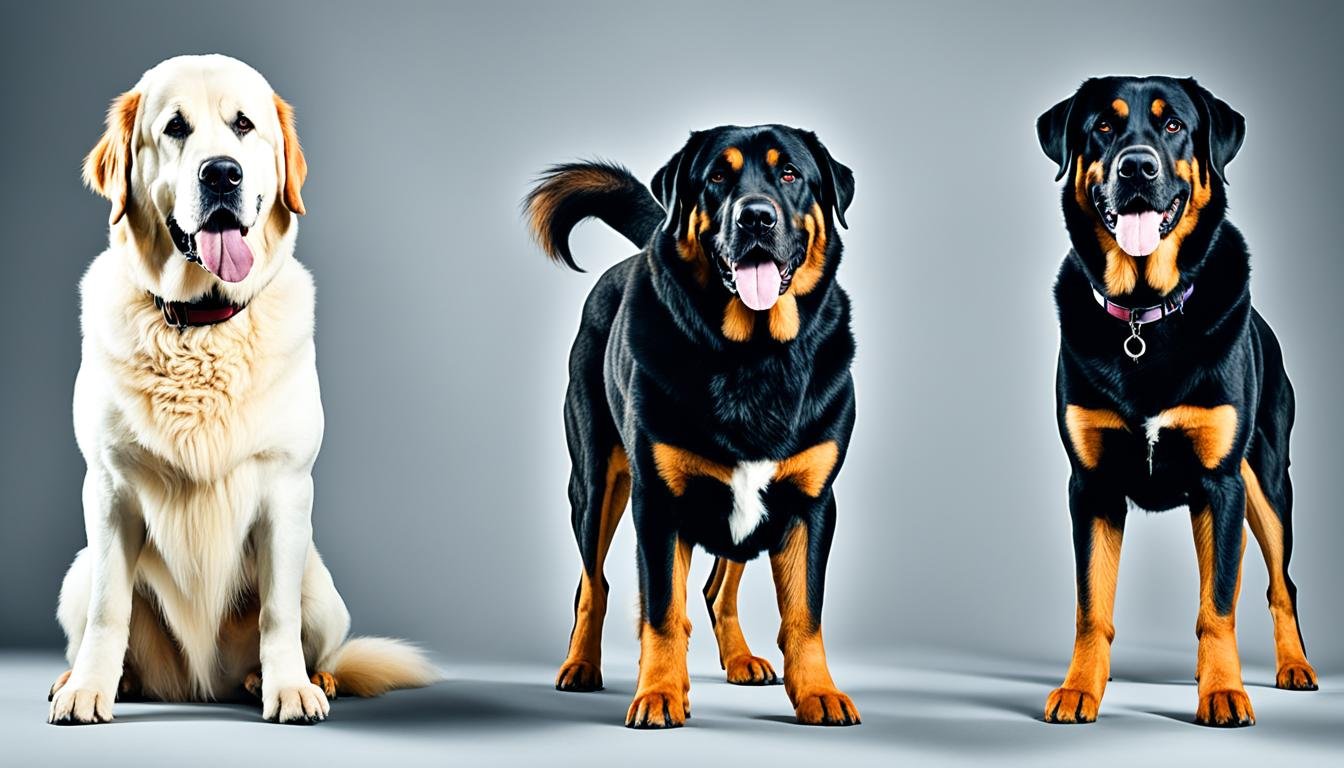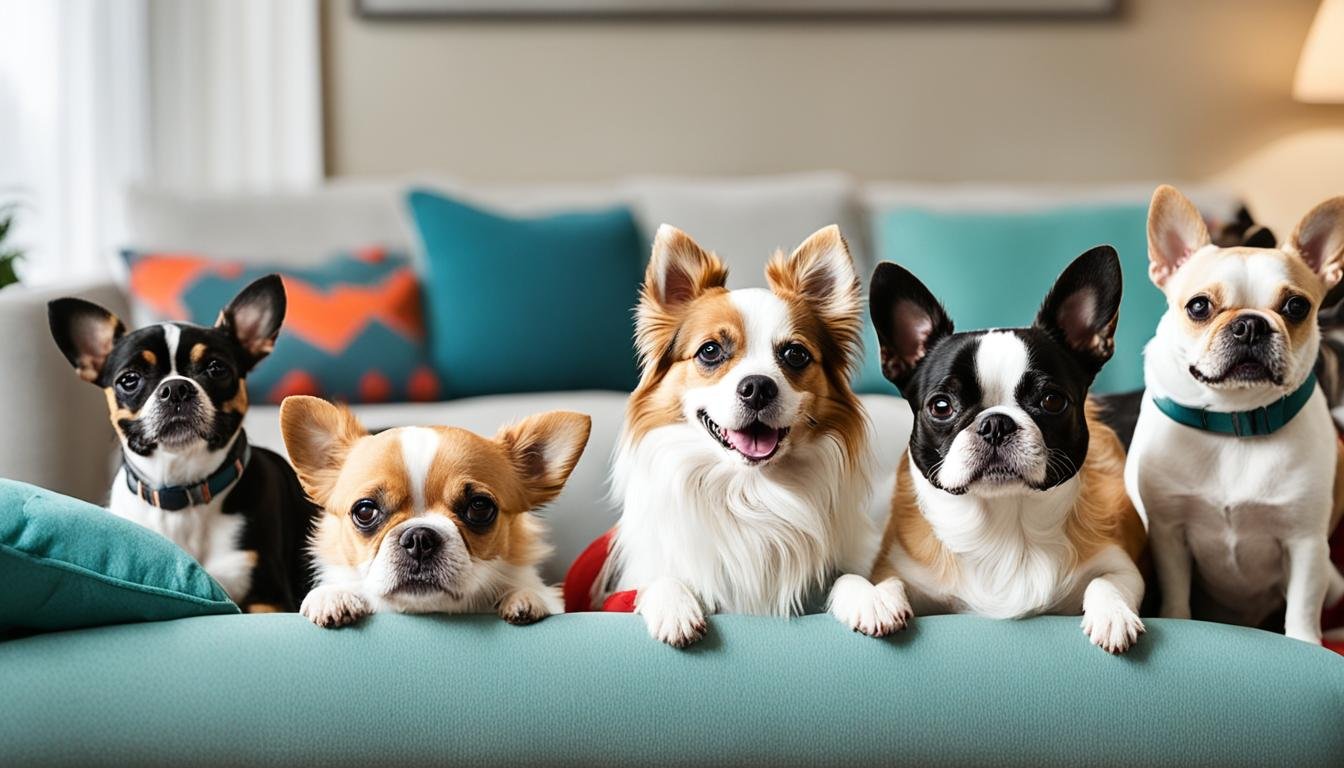Imagine a dog so massive it could easily rest its head on your shoulder, yet still greet you with a gentle, loving demeanor. These are the giants of the canine world – the extra-large, heavy-boned, and towering breeds that capture our hearts and imaginations. But what exactly defines a “giant” dog, and how do these colossal canines differ from their large or standard-sized counterparts1?
Giant dog breeds are generally considered to be within the weight range of about 90 to 200 pounds, with some individuals reaching even higher weights1. These pups are not only impressively large, but they also possess a unique combination of strength, intelligence, and affectionate personalities that set them apart from other dog categories. From the majestic Great Dane to the powerful Mastiff, giant breeds come in a variety of shapes, sizes, and temperaments, each with its own distinct charm and appeal.
Key Takeaways
- Giant dog breeds are generally considered to be within the weight range of about 90 to 200 pounds, with some individuals reaching even higher weights1.
- Large dog breeds typically fall within an average weight range of 55-90 pounds1.
- Giant breeds have a shorter lifespan compared to smaller breeds, with an average lifespan of 8-10 years1.
- Larger dogs, including giant breeds, tend to reach their senior years earlier due to their fast growth rate, which causes them to age quicker1.
- Giant breeds have a higher chance of developing health issues such as hip or elbow dysplasia, arthritis, wobbler syndrome, dilated cardiomyopathy, and cherry eye1.
Understanding Giant Breed Dogs
What Defines a Giant Breed?
The primary distinction between giant and large breed dogs is their weight. Breeds with an average weight range of 55-90 pounds are considered large, while giant breeds typically weigh 90 pounds or more, with some reaching the mid-100 range or even 200 pounds2. Although all dog breeds have a standard weight range, the exact number can vary based on your dog’s age and whether they are male or female. Typically, if you monitor your puppy’s weight from a young age, you should have a decent prediction of where their weight will fall when they are a full-grown adult.
Weight Range and Common Breeds
Some of the most well-known giant breed dogs include the Great Dane, Mastiff, Saint Bernard, Boerboel, Newfoundland, Leonberger, Anatolian Shepherd, and Greater Swiss Mountain Dog3. These breeds can range in height from 22 to 32 inches at the shoulder and weigh between 80 to 230 pounds, with an average life expectancy of 6 to 13 years3. It’s important to note that proper nutrition and care are crucial for the health and longevity of these giant breed dogs.
“Feeding trials by AAFCO ensure puppy food safety and nutritional adequacy.”2
Caring for giant breed dogs requires special considerations, such as a tailored diet, regular veterinary checkups, and diligent training and socialization4. By understanding the unique needs of these majestic canines, you can ensure they thrive and enjoy a long, healthy life by your side.
What is considered a giant breed dog?

When it comes to the canine kingdom, a dog is considered a giant breed when it reaches a significant weight, typically around 90 pounds or more5. Some experts even begin categorizing dogs as “giant” once they surpass the 100-pound mark5. While the lower end of the giant breed weight range starts at 90 pounds, these majestic pups can easily balloon up to the mid-100s or even reach a whopping 200 pounds67.
Among the most well-known giant breed dogs are the Akita, Anatolian Shepherd, Bernese Mountain Dog, Bullmastiff, Cane Corso, Doberman Pinscher, English Mastiff, Giant Schnauzer, Great Dane, Great Pyrenees, Greater Swiss Mountain Dog, Irish Wolfhound, Komondor, Leonberger, Newfoundland, and Rottweiler5. These impressive canines not only captivate us with their sheer size but also with their unique personalities and impressive physical capabilities.
While the weight and height thresholds for a dog to be considered a giant breed may vary slightly, one thing is certain: these larger-than-life pups demand special care and attention to ensure their well-being and prevent potential health issues. Understanding the unique characteristics and needs of giant breed dogs is crucial for any prospective pet owner.
Caring for Giant Breed Dogs

Caring for a giant breed dog requires a unique approach compared to smaller canines. While many aspects of their care are similar, the sheer size of these gentle giants necessitates special accommodations. The most significant difference lies in the associated costs, as caring for a giant breed can be more financially demanding8.
Extra Expenses and Giant-Proofing Your Home
Giant dogs can weigh as much as some grown adults8, and they don’t generally live as long as smaller dogs8. Their voracious appetite means you’ll likely be purchasing much larger bags of food, which can quickly add up. Additionally, professional grooming for a giant breed may cost more than for a smaller pup8.
To ensure your home is safe for a large canine, you’ll need to consider counter surfing and other potential hazards. Keeping enticing items out of reach, whether edible or not, is crucial to avoid unexpected trips to the emergency vet8. You’ll also need to factor in the height of any baby gates or fences to accommodate your giant’s size8.
| Expense | Consideration for Giant Breeds |
|---|---|
| Food | Giant dogs can eat up to 4 cups or more of food per day, requiring larger and more expensive bags8. |
| Grooming | Professional grooming for a giant breed may cost more than for a smaller dog8. |
| Home Modifications | Taller baby gates and fences may be needed to keep a giant breed safely contained8. |
Caring for a giant breed dog requires diligence, patience, and a willingness to adapt your home and lifestyle to accommodate their unique needs. By understanding the extra expenses and taking steps to giant-proof your living space, you can provide a safe and comfortable environment for your gentle giant89.
Conclusion
Giant dog breeds, also known as extra-large or gentle giants, are the biggest pups that captivate our hearts. Though they are sizeable in stature and often have a deep, loud bark, giant breeds are consistently some of the best cuddlers, the most loyal companions, and the friendliest additions to families10. Dogs are considered a giant breed when they reach roughly 90 pounds or more, with some reaching the mid-100 range or even 200 pounds1011.
Caring for a giant breed dog requires special accommodations due to their unique size, including extra expenses for food and grooming, as well as giant-proofing your home to prevent counter surfing and other potential issues1012. While these gentle giants may come with additional responsibilities, their unwavering devotion and affectionate nature make them cherished members of the family for many dog enthusiasts.
Ultimately, understanding the characteristics and care needs of giant breed dogs is essential for prospective owners to ensure a positive and fulfilling experience with these majestic pups. By providing the proper environment, nutrition, and veterinary care, you can help your giant breed dog thrive and become a beloved companion for years to come.
FAQ
What is considered a giant breed dog?
Dogs are considered a giant breed when they reach roughly 90 pounds or more, with some reaching the mid-100 range or even 200 pounds. Some common giant breeds include Akitas, Anatolian Shepherds, Bernese Mountain Dogs, Bullmastiffs, Cane Corsos, Doberman Pinschers, English Mastiffs, Giant Schnauzers, Great Danes, Great Pyrenees, Greater Swiss Mountain Dogs, Irish Wolfhounds, Komondors, Leonbergers, Newfoundlands, and Rottweilers.
What defines a giant breed?
The main difference between giant and large breed dogs is their weight. Breeds with an average weight range of 55-90 pounds are considered large, while giant breeds typically weigh 90 pounds or more, with some reaching the mid-100 range or even 200 pounds.
What are the common giant breed dogs?
Some common giant breeds include Akitas, Anatolian Shepherds, Bernese Mountain Dogs, Bullmastiffs, Cane Corsos, Doberman Pinschers, English Mastiffs, Giant Schnauzers, Great Danes, Great Pyrenees, Greater Swiss Mountain Dogs, Irish Wolfhounds, Komondors, Leonbergers, Newfoundlands, and Rottweilers.
What extra expenses come with owning a giant breed dog?
The main difference with such a big dog is that the associated costs will also be more significant. Giant breeds could eat four cups or more of food daily, meaning you will most likely want to buy much larger bags, which will inevitably cost more. Another expense to factor into your budget is if you choose to have your dog professionally groomed, as your pup’s appointment may cost more than a smaller dog’s.
How do I “giant-proof” my home for a giant breed dog?
With a taller-than-average dog in your home, you may quickly discover that counter surfing (having your dog’s nose graze the counter) becomes a common occurrence. To avoid upset tummies or possible trips to the emergency veterinarian, don’t leave any enticing items sitting out in the open, whether edible or not. You will also need to consider the height of any baby gates or fences around your home or property.







